Hack65.Astronomy Software in the Palm of Your Hand
Hack 65. Astronomy Software in the Palm of Your Hand
Using the shareware Planetarium application for the Palm, you can keep your astronomy software right where you need it. One of the fundamental problems for all amateur astronomers, especially beginners, is finding objects in the night sky. The sky is huge, and the field of view through a telescope eyepiece is extraordinarily small, so the likelihood of finding any specific deep-sky object without some specific observing aid is very low. One solution to this problem is a computerized GOTO scope, which has become an increasingly popular option for people who want to spend less time finding objects and more time looking at them. But many people also enjoy the challenge of finding objects manually. Indeed, my teenage son enjoys the "thrill of the hunt" even more than viewing the objects themselves. For finding objects on your own, you must have accurate maps of the night sky. Books and atlases like Sky Atlas 2000.0 and Uranometria are wonderful resources, but they don't provide a real-time picture of the night sky: you have to contort the page at various angles to match the appearance of the stars. And while large atlases are nice to use on a table, they are not very convenient to hold at the eyepiece. Alternatively, you can print out detailed current star maps from astronomy software. But that can be cumbersome and limited to specific areas that you choose in advance. What if you change your mind and want to look at a different area? Or clouds cover up the area that you planned? Another alternative is to use astronomy software loaded on laptop computers. The computer will provide views to match what you will see in the sky. But it is also cumbersome: bringing the laptop to the eyepiece with you in the dark is neither convenient, nor healthy for the laptop. One solution to these problems is to use astronomy software written specifically for the Palm and other handheld personal digital assistants (PDAs). If you're like me, you may already own a PDA to store addresses and run your daily calendar. If so, the main cost of this system is already paid for, since much of this software is modestly priced. While astronomy software on a handheld PDA might not have all the features of a high-end astronomy software package, the portability of a PDA is appealing. With a PDA, you can essentially hold a current map of the night sky in your hand at the eyepiece, with its screen zoomed in at whatever field of view you need, and you can access different screens by tapping a stylus instead of using a keyboard or mouse. One popular astronomy program for the Palm is Planetarium, shown in Figure 4-50. I have used this software for several years, and it has become one of the most indispensable parts of my observing package. Planetarium is sold and downloaded online (http://www.aho.ch/pilotplanets/) as shareware. You download a demo version for free; if you like it, you pay the developer $24 for a code that activates the full version. The developer of this software is Andreas Hofer who has been helpful in creating upgrades and answering questions. In addition, you can join the online Yahoo group for astronomy PDA use, the PalmAstro group, http://groups.yahoo.com/ group/Palmastro/. 4.23.1. Features of PlanetariumWhen you first use Planetarium, you enter your location and time zone, either from a large built-in database of cities around the world, or from latitude and longitude coordinates obtained elsewhere (the database at the Heavens Above web site is particularly useful: http://www.heavens-above.com). Your PDA needs to be set already with the correct time and date; these data provide Planetarium with the information it needs to give you accurate positions of celestial objects at any time from your location. If you change your location of observing, you simply tap on a new location from a pull-down menu; I have three custom locations set to the sites where I commonly observe. Figure 4-50. Software at the eyepiece: using a Palm with Planetarium software to find objects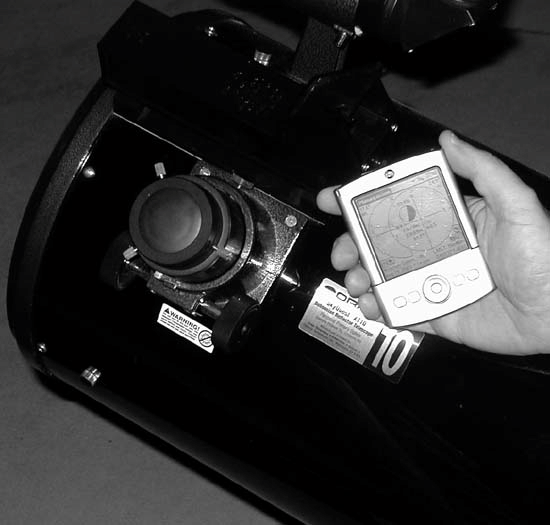 4.23.1.1 Views.Planetarium views objects in two ways: a compass screen (Figure 4-51) and a sky view screen (Figure 4-52). The compass screen shows objects in two views: azimuth (as they would appear on a compass) and altitude. Tapping an icon switches over to the sky view screen, which shows objects as they appear in the sky relative to nearby constellations. Both views display current altitude and azimuth coordinates for selected objects. Figure 4-51 shows a Planetarium compass view. The altitude direction shows Mars at 20.3° from the horizon (H); the azimuth view shows Mars in the southeast, with an azimuth of 122.5°. Figure 4-52 shows a Planetarium sky view with a field of view of 60°, with Mars centered in the screen in the constellation of Aquarius. Figure 4-51. Planetarium compass view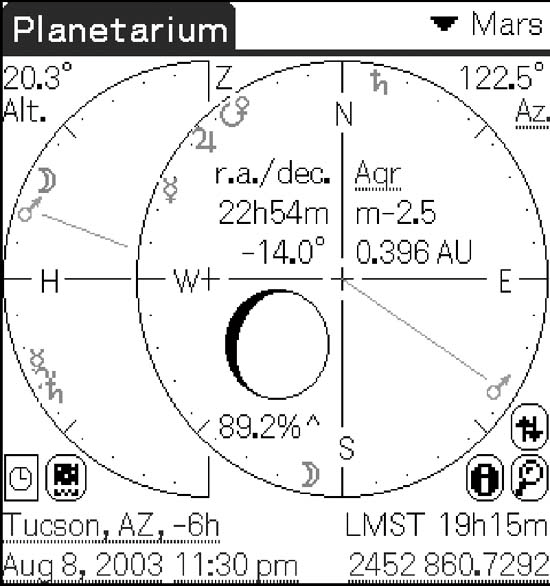 Figure 4-52. Planetarium sky view Objects are grouped (planets, stars, DSOs), and selected by tapping a pull-down menu. Once selected, the object appears on the screen surrounded by circles representing a Telrad finder. If you like, you can tap an information icon that provides you with background information (e.g., distance, size, rise/set times). Tapping on another pull-down menu varies the field of view of the sky image, from 180° to 1°, with numerous increments in between. This way, you can see the object as it appears to the naked eye overhead, and then zoom to a smaller field of view as it appears in a finder scope. Tapping another pull-down menu adjusts the time increment, from 1 minute to 90 days. You use the PDA's up/down button to show the position of the object at any time selected. Tapping a handy clock icon automatically resets the screen to the current time. The time increment button is important for planning observing sessions for months or days in advance, or in previewing positions of objects during an observing session. For example, I often want to know when a specific object will rise over a tree or roof-top, and this feature allows me to determine that easily. It's also useful to check out conjunctions, occultations, and eclipses in advance, all customized for your location. 4.23.1.2 Databases.Several different databases can be freely downloaded for Planetarium, depending on the level of detail you need. For example, the basic download contains either 9,096 stars, or if you are low on memory, 1,600 stars. I find the 9,096 version to be much more useful; it is similar to the number of stars you might see in a typical finderscope. Stars are listed by names or by the standard conventions (Yale, Bayer, and Flamsteed [Hack #15]). The standard database comes with the full lists of Messier and Caldwell objects, while an advanced download contains the Herschel 400 list of NGC objects, and an even more advanced list contains over 1,000 deep-sky objects. There is also a list of asteroids and comets. Several other custom download lists are available from the Planetarium web site. Databases can be edited by the user. For example, if a new comet or asteroid is discovered, you can download the ephemeris (e.g., from http://cfa-www.harvard.edu/iau/Ephemerides/index.html) and add it to the list. This is a critical use of the software. After all, the locations of comets and asteroids are not listed on standard atlases, and if you want to do any comet hunting, it is extremely valuable to have that capability in your hand at the eyepiece. 4.23.1.3 Session planning.In addition to the object you selected, the compass view of Planetarium also shows the current phase of the moon, giving you a quick look to see whether the moon will be a factor in your observation plans. Tapping on the moon leads you to the twilight screen in a couple of taps, which gives you a quick run down on the vital statistics of the day, including rise and set times of the sun and moon, and exact times for twilight (civil, nautical, and astronomical). Moving the up/down button on the PDA provides you with this twilight information for other days, depending on the time increment you selected. 4.23.1.4 Log entries.Planetarium also contains an automatic log feature. If you want to log an object you've just observed, tapping the log icon will automatically add it as an entry into your personal logbook, including the object name and current time. Then you can add any other pertinent information if you like. I keep a simple one-letter code system where I can use the stylus to quickly enter the parameters of the observation. For lazy observers like me who just can't seem to get organized with a logbook, this feature is invaluable. 4.23.2. Locating Objects Manually with PlanetariumA primary goal of using PDA-based software is to find objects with minimum hassle. A PDA has a major advantage: you can take it with you to the eyepiece, where you have a real-time map of the sky to match the view you see in the finder. Whether you use a unit power finder like a Telrad or Rigel QuikFinder, or a finderscope, Planetarium is ideal for this purpose. To accomplish this, you simply tap on a pull-down menu to select an object. You'll see the object with its relevant constellations in the Sky View screen, surrounded by Telrad circles (0.5°, 2°, and 4°). With the PDA in your hand, it's easy to match the position of the finder on your scope with the image on the screen. Starting with a wide view in the PDA (like 45°), you use the Telrad to point to the general area of the sky, and then quickly tap on the zoom view to narrow your field of view. Sometimes I end up with a custom view of 7° to precisely match the field of view of my finderscope. Figures 4-53 and 4-54 show the process of finding M57 with Planetarium. First locate the general position of M57 in Lyra with a wide view of 45° (Figure 4-53), then zoom to 10° for a close-up view (Figure 4-54). Dotted circles represent a Telrad unit finder. This is a quick and easy method to find objects. For example, my son and I have used it successfully in Messier Marathons to find over 100 objects in one night. Figure 4-53. Locating the general position of M57 in Lyra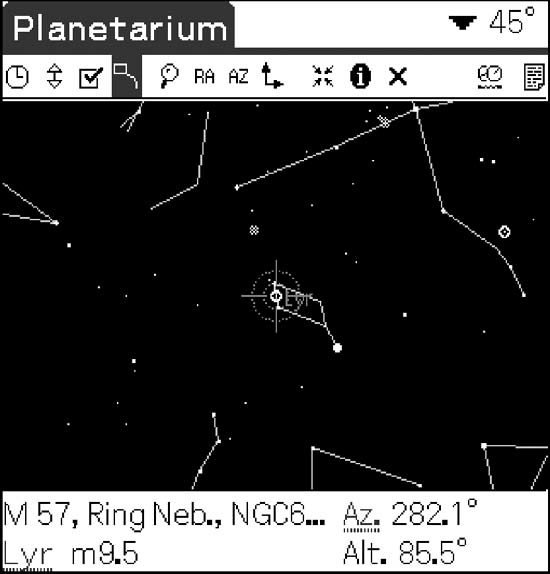 Figure 4-54. Zooming in to a detailed map for M57 4.23.3. Using Planetarium with Manual Setting CirclesFor finding objects, many amateur astronomers find the setting circles on equatorial mounts to be virtually worthless because their small size precludes any degree of accuracy. But Dobsonians have large bases ideal for mounting setting circles. When used properly, these circles can quickly find virtually any visible object. Astronomy software provides the updated altitude and azimuth coordinates needed to find objects, and the most convenient way to do this is to use a PDA in conjunction with the circles. Altitude and azimuth circles for Dobsonians are relatively easy do-it-yourself projects for Dob owners. Details for constructing and using these circles can be found on the Web (for example, see the Yahoo Skyquest forum and do a search under "azimuth ring": http://groups.yahoo.com/group/skyquest-telescopes/). The altitude circle is simply a protractor attached to the altitude bearing, while the azimuth circle is attached to the base of the scope with brackets so that it can be moved during alignment. Figures 4-55 and 4-56 show homemade manual setting circles on a 10-inch Dob. Figure 4-55 shows the altitude circle, and Figure 4-56 shows the azimuth circle. Using PDA-based software like Planetarium is a convenient way to provide updated alt-az coordinates for objects. Figure 4-55. The altitude circle shows an altitude of about 44°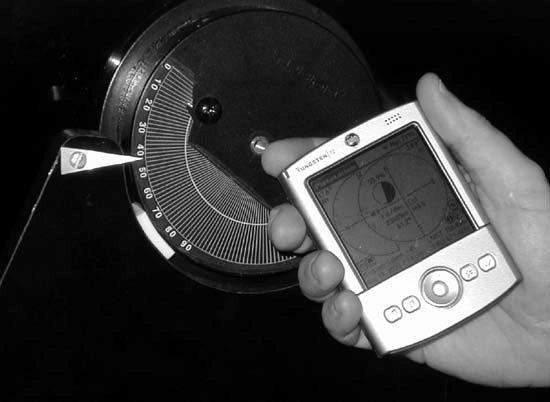 Figure 4-56. The azimuth circle shows an azimuth of about 180°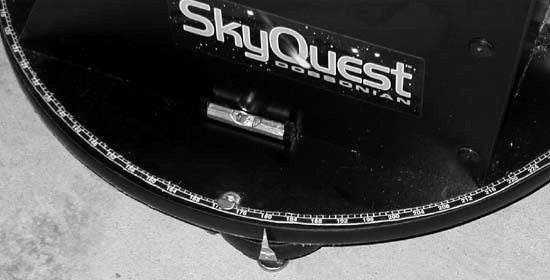 To align the circle, you find a known object (a bright star or planet), center it in the eyepiece, and look up its coordinates on the PDA. Then you simply move the azimuth circle around the base so that its pointer matches the azimuth in the PDA, and the circles are now aligned for the night. Throughout the night, you select an object in Planetarium to automatically provide its alt-az coordinates, then move the scope to these coordinates to locate the object quickly. One caveat: in order to work accurately, the base of the scope must be level. This is monitored with bubble levels glued at right angles on the base, then use either leveling feet or simple wooden wedges to level the scope. The leveling process only takes a couple of minutes each night. 4.23.4. Other UsesThe portability and features of Planetarium on the Palm give it a variety of other uses:
4.23.5. Bottom LineNothing is perfect, and there are a few problems using Planetarium and a PDA at the eyepiece. Most of these issues are associated with the PDA itself rather than the software. For example, some observers have trouble seeing the symbols and icons on the small screen of the PDA. Ultimately, this is the price you pay to have a screen in your hand at the eyepiece. Most annoying to your fellow observers is the light emanating from the PDA screen, which seems to be precisely situated to ruin your colleagues' night vision. Once again, this is not the fault of the software because Planetarium has a night vision mode in which the screen is lit with red light. Unfortunately, the Palm has an obnoxious white light that escapes from the edge of the screen. I solved this problem by attaching red film to the screen [Hack #44]; the Palm has a small gap between the frame and the screen where you can insert a sturdy piece of red film to block the white light. On some models, you can also turn off the backlit screen of the PDA and see the screen views with your red flashlight. Other astronomy software will provide the basic features you find in Planetarium and include more advanced features as well. Certainly, Planetarium cannot replace the full features of a high-end astronomy program. But the advantage of PDA-based software is to use its portability to simplify the amateur astronomer's life. Armed with just a PDA, you can eliminate your star atlas, printouts of star charts, logbook, laptop computer, and folding table. Your overall setup is faster and easier, and the reliability of the locating system means that you can spend your time observing, not fumbling around in the dark. Steve Childers |
EAN: 2147483647
Pages: 112
- ERP Systems Impact on Organizations
- ERP System Acquisition: A Process Model and Results From an Austrian Survey
- The Second Wave ERP Market: An Australian Viewpoint
- The Effects of an Enterprise Resource Planning System (ERP) Implementation on Job Characteristics – A Study using the Hackman and Oldham Job Characteristics Model
- Healthcare Information: From Administrative to Practice Databases